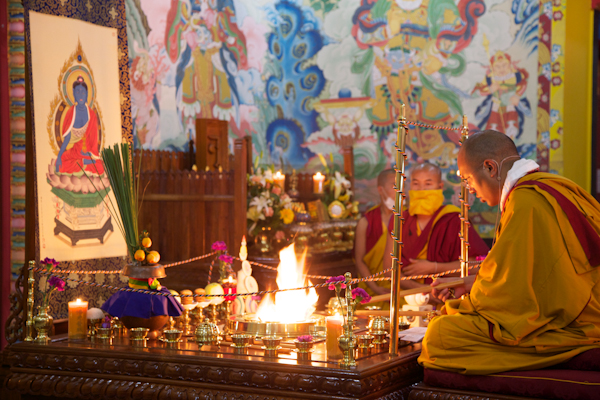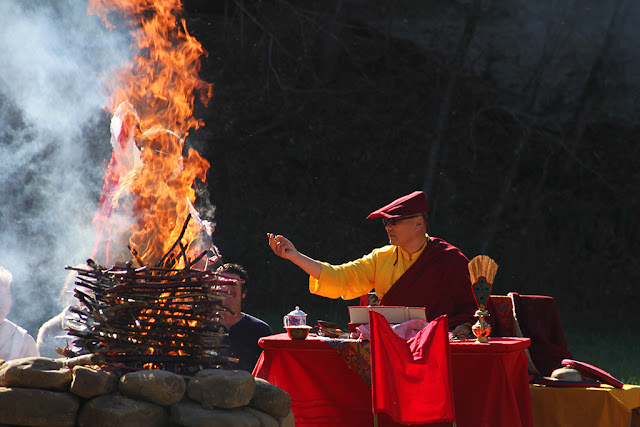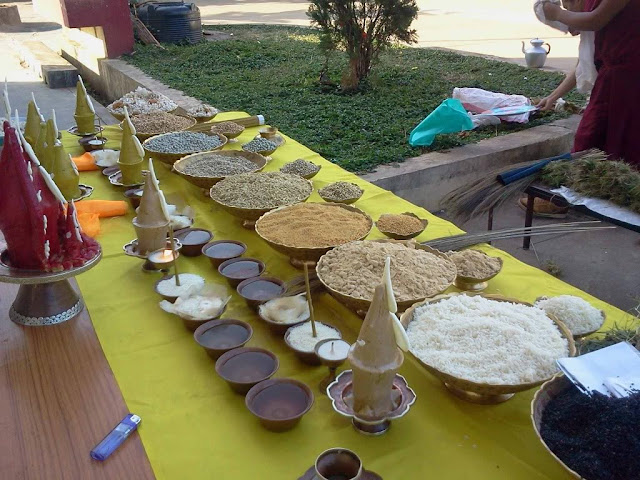Fire Puja offerings are ritual offerings of smoke, smell and flaming made Offering to the Four Guests:-
There are three different types of fire-related pujas:-- Smoke Offering (Sang)
- Smell Offering (Sur)
- Fire Offering (Jinsek)
The major principle of fire Pujas is offering. One casts onto a fire and flame a dry powder of juniper, rhododendron, and other plants, mixed with the three white [milk, yogurt and butter] and the three sweets [honey, molasses and white sugar]. You put the food and whatever ingredients in the fire. As the fire burns it, it is totally consumed and in this way it is offered.
In the "Sang" - You are offering the smoke, in the "Sur" - You are offering the smell or scent. In the "Jinsek" - You are offering fire itself, the flame itself, and burning itself. If one is making the sang and sur offerings, consistency is important as the guests for whom the offerings are made come to anticipate the ceremony.
However, the inability to carry out the practice daily or even weekly should not dissuade one from making the offering as often as one is able. Also, it is always possible to make donations to the lamas at the monasteries, temple to carry out the practices on the behalf of yourself or others, including whatever prayers, Puja you wish.
Smoke offerings (Sang)
Sang is mainly dedicated to what is referred to as “elemental spirits”– the gods of the mountain, the gods of the sky, the gods of the river, and the gods of all aspects– and “local deities.
Though only seen through expansive and refined sense perceptions, we can experience these classes of beings through observing signs in the natural world. including animals, features of the land, and weather patterns. In addition to these particular guests, we also offer to the aforementioned “four guests”.
Though only seen through expansive and refined sense perceptions, we can experience these classes of beings through observing signs in the natural world. including animals, features of the land, and weather patterns. In addition to these particular guests, we also offer to the aforementioned “four guests”.
Where and when is Sang best offered
Sang is generally practiced in the daylight hours (usually before noon) and offered near one’s dwelling or on the top of a mountain. It can be offered anywhere that one wishes to renew and repair the connection with the elemental constituents of the area.
The offering and intention create the causes and conditions for harmonious internally among the beings that inhabit the place, as well as externally in the environment itself. In this way, it can be an important step in the process of purifying gross and subtle levels of environmental pollution.
The offering can also effect change in the experience of the beings that inhabit the place, for example, healing discord in one’s family or pacifying animals and pests.
What is offered
The offering can also effect change in the experience of the beings that inhabit the place, for example, healing discord in one’s family or pacifying animals and pests.
What is offered
It is very important for the Sang offering to be clean. The offering of the short morning fire Puja can be quite small, a few teaspoons of the “sangdze” (Tibetan word literally means offering substance) is sufficient, though elaborate versions can consist of 10 or more large trays of heaped offerings along with beer and wine. We then infinitely expand the offerings by visualizing them as billowing clouds that fill the extent of space.
The offering substance, consists of a mixture of “the three white” and “the three sweet”
The three white substances are flour, butter, yogurt.
The three sweet substances are sugar, molasses, and honey.
Other substances are included of incense, 5 colored cloths, medicine, alcohol, and precious stones or jewels.
What not to offer
No onion, garlic, meat, or eggs. A minor eggs ingredient that has made in some baked goods can be allowed.
Smell or scent offering (Sur)
Is mainly dedicated to the unseen beings and spirits that including the hungry ghosts that with whom you have a karmic debts.
Where and when is Sur best offered
Offered in locations similar to those of Sang.
Typically offered in the afternoon or evening.
Offerings and prayers are given on behalf of the deceased loved ones throughout the entire 49 days that they may exist in the intermediate Bardo state. It is a common practice among Tibetan Buddhists to make personal offerings for their deceased loved ones to relieve from attachment to their previous existence and facilitate an auspicious rebirth.
It is ideally consists of all kinds of food and drink that beings desire, including meat and alcohol. Vegetarian food will be ideally and a better way of offering. In this way one can practice compassion and Bodhichita by abstaining of killing and animals scarified.
As with any practice, the merit generated is multiplied by the number of people who participate in the chanting or donation of offerings. Everyone is welcome to assist in the preparations of the fire and offerings. This can include procuring the wood as well as purchasing the food.
Fire offering ( Jinsek )
Fire offering ( Jinsek )
Fire Puja, or fire offering, is a ritual practice of offering into the fire, a ritual of generously burning offerings, using the fire element to accomplish an enlightened action quickly and powerfully.
According to the secret Vajrayana teachings include the practice of Jinsek. Every item offered in burning Pujas is good for some purpose.
By offerings grains pacify sickness and to give strength.
By offerings crepe grass to gain healthy long life.
By offerings Kusha grass to purify pollutions.
By offerings butter to gain wealth.
There are various substances that are offered to the deity during the fire Puja. Each mentioned substance has the potential power to affect your life. Like this, all the substances offered are to actualize different potentials and types of success.
There are four Jinseks of fire Pujas are performed to accomplish the enlightened activities. Each Jinsek is performed by a different lama and corresponds with specific colors, directions, times of day and energies. The benefits of performing Jinseks, or even making a connection with them, are immense, both relatively and ultimately.
The four Jinseks practices
"Heals imbalances of physical elements that result in sickness; removes negative energy for us personally and the world in general; pacifies karmic defilements of countless lifetimes and liberates us from unwanted circumstances."
"All enemies, obstructed and those who bring harm both to worldly life and the path of enlightenment are eliminated and liberated.
3) Magnetizing (Wang-gi Jinsek in the afternoon)
"Any worldly desirable qualities and glorious qualities of the Dharma path, such as meditative experience, realization and enlightened wisdom qualities are magnetized and brought under one's control."
4) Enriching (Gyaybay Jinsek in the morning)
"Longevity, merit, glory, wealth, splendor, powerful influence, fame, good reputation, wisdom and all enlightened qualities are enriched and expanded."
Generally, the burning Puja is offered at the end of great nearing retreats, three-year retreats, or short retreats of the enlightened being deities. These retreats are done with mantra recitation that brings you closer to the deity.
The fire Puja is offered to restore parts of the practice that were left out, or mantras that have been incorrectly recited or mixed up, performed with unclear concentration. It also generally purifies defilements and negative karma.
*Footnote
For those who had received the empowerment of this Tantric practice, you are reminded not intentionally or unintentionally to disclose the mantra to the public or anyone who may not have the empowerment or permission to practice, and by disclosing the mantra intentionally or unintentionally is a form of breaking your Tantric Samaya vows to the lineage masters and Dharma protectors. Please consult your Guru or a qualified lineage master for Vajrayana practice! Should a devotee even want to start studying and contemplating the Vajrayana practice, then it is truly necessary to first have completed the preliminaries and to be certain and sure that Bodhicitta has arisen and developed in one’s mind.
Vajrayana features countless skillful and powerful methods which, if they are practiced in the proper way, can make the process of accumulation and purification incredibly swift and direct. It is absolutely necessary to have the pure motivation and to know that Vajrayana practice is not carried out to increase one’s own ego, power and self-interest.
Every drop of water helps to swell the ocean
Every good and bad action will not go unnoticed
Do you earnestly cherish our devoted work? Assuming this is the case, would you consider making a donation for our Buddhist research and development. We need you to help secure the future of scholarly interaction with Buddhism.
Your generosity will certainly help us improve our works and to achieve for a better and brighter prospect to come.
Thank you for reading, may you find peace and great bliss. With your support it helps to spread the Buddha’s precious teachings and turning the Dharma wheels in the world.
Aspiration For Bodhichitta
For those in whom the precious Bodhichitta has not arisen
May it arise and not decrease
But increase further and further.
Dedication of Merit
By this merit may we obtain omniscience then.
Having defeated the enemies wrong-doings.
May we liberate migrators from the ocean of existence.
With its stormy waves of birth, old age, sickness and death.
*Note
I do not own or infringe any copyright of the picture(s).
Picture(s) courtesy and credit to the rightful distributors and or studios.
Picture(s) is/are intended for editorial use only.



























